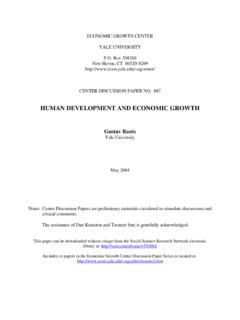Transcription of Systems Theory - SAGE Publications Inc
1 11 Systems TheoryBRUCE D. FRIEDMAN AND KAREN NEUMAN ALLEN3 Biopsychosocial asse ssm ent and the develop-ment of appropriate intervention strategies fora part icular client require consideration of the indi -vidu al in relation to a larger social context. Toaccomplish this, we use principles and conceptsderived from Systems Theory . Systems Theory is away of elaborati ng i ncreasingly c ompl ex systemsacross a continuum that e nco mpas ses the per son-in-environment (Anderson, Carter, & Lowe, 1999). Systems Theory also enables us to understand thecomp onents and dynamics of client Systems in orderto interpret problems and develop balance d inter-vention strategies, with the goal of enhancing t he goodness of fit between individuals and theirenvironments.
2 Systems Theory does not specify par-ticula r theoretical f ram eworks for understandingproblems, and it does not direc t the so cial worker tospecific interventi on st rategi es. Rather, it serves asan organizing conceptual fram ework or me tatheoryfor understanding (Meyer, 1983).As a pro fessi on, social work h as struggled toidentif y an organizing framework for practice thatcaptures the nature of what we do. Many have iden-tified sy ste ms Theory as that organizing frame work(Go ldst ein , 1990; Hearn, 1958; Meyer, 1976, 1983;Sipo rin, 1980). How eve r, bec ause of the c omplexnature of the clinic al ent erpri se, other s have chal -lenge d the suitabilit y of Systems Theory as an or ga -nizing framework for clinical practice (Fook, Ryan,& Hawkins, 1997;Wakef ield, 1996a, 1996b).
3 The term syst ememerged from mile Durkheim searly s tudy of social Systems (Robbins, C hatterjee,& Canda, 2006), as wel l as from the work ofTal cott Parsons. However, withi n social work, sys -tems thinking has been more heavily influenced bythe work of the biologist Ludwig von Bertalanffyand later adaptations by the social psychologist UriBro nfenbrenner, who examined human biolog icalsys tems within a n ecological environment. Withits roots in v on Bertalanff y s sys tems Theory andBronf enbre nner s ecologi cal environment, theecosys te ms perspective provides a framework thatpermits users to draw on theories f rom different dis -cipli nes in order to analyze the complex nature ofhuman interactions within a soci al HISTORYL udwig von Bertal anffy (1 901 1972), as mentionedabov e, i s cred ited with being the originator of theform of Systems th eory used in social work.
4 VonBertalanffy, a theoretical biologist born and educatedin Aus tria, became dis satis fied with the way linear,cau se-and-effect theories explained growth andchange in living organisms . H e felt that change mightoccur because of the interac t ions between the partsof an organism, a point of view that represented adramatic chan ge from the theories of his ting theories had tended to be reduct ionis t,understanding the whole by breaking it into its part Bertalanffy s introduction of Systems theor ychanged that fr amework by looking at the systemas a whole, w ith its re lat ionships and interactionswith o the r sy st ems, a s a mechanism of growt h andchange.
5 Thi s cha nged the way people looked at sys-tems and led to a new language, popularizing termssuch as open and closed Systems , entr opy,boundary,homeostasis,inputs, outputs,and Systems Theory is likened to a science ofwholeness. Von Bertalanffy (19 68) a dvocated anorganismic conception in bi ology that emphasizedconsideration of the organism as a whole or a sys-tem (p. 12). He saw the main obje ctive of the bio -logi ca l sciences as the discovery of organizationalproperties that could be applie d to organi sms at var-ious levels for analysis. This led to the basic assump-tion that the whole is mor e t han the sum of itsparts (p. 18). Von Bertalanffy s ap proach is derivedfrom a basic concept that relies heavily on linear-base d, cause-and -effect properties to expl ai n growthand change in liv ing organisms.
6 There are two con-ditions on which these properties depend: ( 1) that anintera ction occurs betwe en parts and (2) t hat thecondition describing the relationship between theparts is lin ear. When these two conditions are pres -ent, v on Bertalanffy felt , the i nteraction was mea-surab le and was subject t o scien tif ic i depicts th e linear nature of the a re inputs, outputs, and outcomes. However,what ha ppe ns in the system is some what mysterious,and one can only me asure the changes by observingthe outputs in rel ationship to the outcomes or goalsof the system. Workers can vary or modify theinputs, inclu ding th eir own actions, to create achang e wit hin the measure the interaction, von Bertalanffyappl ied basic scientific principles to various types oforg anisms that explain and measure behavior.
7 It isimpo rtant to understand that von Bertalanffy s ori g-inal conception of sys tems Theory was one of orga -nization. He saw it as a method of organizing theinteraction between component parts of a largerorg anism. Since it was a way of org anizing informa-tion rather than explaining observations, it was easily adaptable to ma ny dif ferent scientific fields,in cluding psychology, psychiatry, sociology, andsoci al work. The important di stinc t ion am ong t hevarious fiel ds adopting these principles was howthe y used other theories to explain the inter actionwithin the org anism. Thus, syst ems Theory i s anorganizational Theory that looks at intera ction sbetween Systems : How a fi eld defines the systemdetermines the nature of the int eraction.
8 VonBertalanffy was infl uenced by a number of soci olo -gists , and their contributions are import ant t o socialwork. To understand more f ul ly t he interactionalproper ties of Systems Theory , it may be useful tounders tand the key concepts used by von Bertalanffyand other Systems Contributions to Systems TheoryVon Bertalanffy was i nfluenced by Durkheim andMax Weber, both of whom were early pioneers inthe field of sociology. They took early Systems the -ory as it was initially applied i n t he l at e 1800s andearly 1900s to biological organisms a nd applied it tohuman social Systems . Durkheim was interested inhow societies were organized and how they main -tai ned cohesion or group identit y over time.
9 Hebelieved tha t hum an beings experience a uni quesoci al reality not experienced by other organismsand that order can only be maintained through theconsent of individuals wi thin the group who sharethe same morals and values. In his 1893 doctoraldissertation, later published as The Division ofLabor in Soci ety ,Durkheim (1984) explained thatin hi ghly organized Systems , the division of laborcontributes to t he maintenance of societies. In com-plex soc ieties, individuals perform various roles that,whi le the y lea d to s peciali za tion and segmentation,also create a high degree of mutual interd ependence4 FRAMEWORKS FOR CLINICAL PRACTICE between units.
10 Although the indi viduals performingthem will change, these roles persist over time andmaint ain a society (D urkhei m, 1984). Durkheimalso wrote about cri me and suicide, be lievi ng bothto be a resu lt of disruptions or imbalances in theintegration o f individuals and socie was particularly interested in h owroles and the division of labor maintained society ina macro sense. For example, the role of the police ina society is to protect citizens from criminals andpreserve order by enforcing the law. The stability orequilibrium of a society is threatened when thepolice a buse their aut ca n al so use role Theory t o j udg e how wellindividuals are functioning at a more micro workers are often cal led on to evaluate howwell mothers a nd fathers care for their children.

















